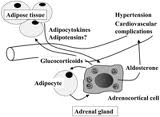Dr. Ludwig gave a lecture about how to avoid being hungry at a conference in Las Vegas. The actual topic was “Always Hungry?” I attended the 24th Annual World Congress on Anti-Aging Medicine (Dec. 9-11, 2016) in Las Vegas where this lecture was given. Dr. Ludwig is a Harvard-based endocrinologist who has been researching weight loss methods and obesity for over 20 years. Here is a list of his major publications.
Dr. Ludwig stated that the low fat/high carb diet popular in the1980’s until the early 2000’s was misguided and probably even harmful. The theory at that time was that obesity was caused by too much saturated fat. This has since been proven to be wrong. Instead it has been proven that increased sugar intake is responsible for the obesity wave.
General information about weight gain
The carbohydrate-insulin model states that without insulin you cannot gain weight, because in order to store fat in fatty tissue you need insulin to transport fatty acids across the cell membrane of fat cells.
In this context it is important to note that high glycemic index food increases the blood sugar. This leads to stimulated insulin production, and the liver converts the extra sugar into fatty acids that get deposited as fat in fatty tissue.
The glycemic load from a person’s diet is the single best predictor for a rising blood sugar level. After food intake the blood sugar goes up, glucagon goes up, epinephrine goes up within 4 hours. It is the epinephrine, which after 4 hours makes you hungry again.
The nucleus accumbens is the addiction center. At 4 hours after a high glycemic index milk shake the nucleus accumbens was stimulated in 12 subjects of a double blind trial.
The nucleus accumbens does not work in isolation. It is not only involved in food satisfaction, but also in sexual satisfaction and even plays a role in satisfaction that some people get from playing video games.
Low-carbohydrate, Mediterranean or low-fat diet
In an Israeli study from the New England Journal of Medicine in 2008 investigators were interested to find out which diet was helping people to lose most weight.
322 moderately obese subjects that were aged 52 years on average were randomized to one of the following diet groups.
They compared
- a low fat diet (Atkins type, restricted calorie) with a
- Mediterranean diet (low carb, restricted-calorie) and a
- Low fat/high carb diet (low fat, non-restricted-calorie)
What was the result? The mean weight losses were: 2.9 kg (low fat group), 4.4 kg (Mediterranean diet group), and 4.7 kg (low fat/high carb group). Of the 272 participants who had completed the intervention after two years of the study the weight loss was 3.3 kg, 4.6 kg, and 5.5 kg in the same sequence as above.
Next the researchers examined the ratio of total cholesterol to high-density lipoprotein cholesterol, which is a measure for the heart attack risk. It was 20% lower from the baseline in group 2 (Mediterranean diet group). The low fat groups (group 1 and 3) were 12% lower from the baseline.
36 subjects had diabetes. There was a clear winner with respect to lower fasting blood sugar and insulin levels, namely the Mediterranean diet (group 2).
The authors concluded that the Mediterranean diet is preferable to low fat diets as they have shown an improvement in lipid profiles and in control of diabetes.
The “POUNDS LOST” study
This was a 2-year study that investigated 4 different lower calorie diets to help people lose weight. Despite the significant difference in diet composition, these 811 free-living overweight or obese adults ages 30-70 from Boston, MA and Baton Rouge, LA lost 16 pounds at 6 months and 9 pounds at the end of two years. The diets were 1) low fat (20%) or 2) high fat (40%) 3) average protein (15%) or 4) high protein (25% of total calories).
The authors concluded that any reduced, calorie-controlled diet would help obese or overweight people to achieve weight loss that lasts. It is interesting that it did not matter whether the diet was low or high in fat, or had low or high protein content. What did matter was that all diets were low in sugar.
Sugar is the driving force
Dr. Ludwig pointed out that without insulin you couldn’t gain weight. High glycemic index food increases blood sugar. The glycemic load is the single best predictor to indicate whether a person will gain weight or lose weight when you consume food. It is an irony that in the 1980’s and 1990’s the wrong assumption that a low fat/high carb diet would be heart healthy created the obesity wave. We have abundant data available that show otherwise: high sugar content of food brings the calorie count up as everybody can read on the food labels.
Sugar stimulates the food addiction center
This will lead to weight increase, which has been abundantly proven. Sugar also stimulates your nucleus accumbens, the food addiction center. As you probably know it is extremely difficult to get out of this food addiction cycle unless you cut out sugar. You even need to go one step further and include many starchy foods that will within 30 minutes of digesting them turn into sugar. Your system makes no difference whether you eat a few teaspoons of sugar or two slices of white bread. The response of your pancreas is insulin, which gladly stores the fatty substances your liver made as fat.
How to get out of the vicious food cycle
As the quoted publications and many other ones have shown, it only matters that you limit your refined carb intake. You can vary the fat content and you can vary the protein content and still lose weight provided you watch the low carb intake. You also need portion control, which is a given! Study glycemic index and glycemic load sites on the Internet. The links I provided are just some examples. The more you educate yourself about carbs, the better for you. Note that many fruit and vegetables belong to the low-glycemic load/index foods. Avoid the high glycemic index foods like dates and cornflakes. Stick to low-glycemic index foods, which are less than 55. With regard to low-glycemic load food the values should be below 10.
The Mediterranean diet is a very desirable diet, which has been proven to be anti-inflammatory.
The zone diet of Barry Sears is also an anti-inflammatory diet and he summarizes this in this link.
Conclusion
I have summarized the content of a talk given by Dr. Ludwig. We learnt from this that sugar and refined carbs are the driving force that leads to “feeling hungry”. This stimulates your nucleus accumbens, the food addiction center. Let’s assume that a person is obese or overweight and wants to lose some weight. You need to start by being strict with yourself. Cut out sugar and high-glycemic foods. This will remove the food addiction factor that keeps you going back to the wrong, high calorie foods. You will also consume more low calorie vegetables and fruit, which have more fiber that fills you up.
Monitor your body mass index
Once you are used to the new way of eating, there is no need to count calories. I recommend that you weigh yourself daily on body composition scales and record the results. This allows you to monitor your body mass index (BMI), your weight, your fat percentage, and your muscle percentage. Typically you will lose 2 to 3 pounds per week on such a low-calorie diet. Later the weight loss will slow down to 1 to 2 weeks per week until you reach your goal. Don’t go lower than a BMI of 21.0 to 22.0 and discuss your goal with your doctor.








